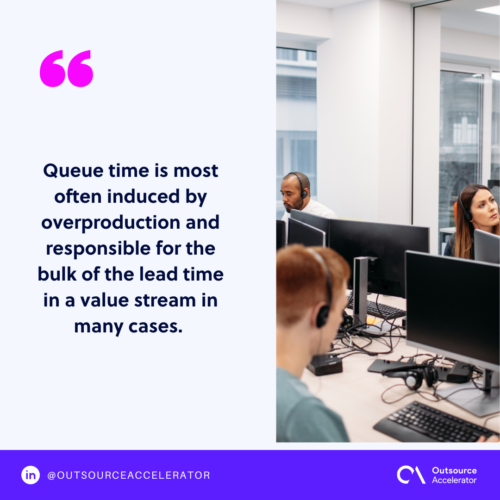Queue Time
Definition
What is queue time?
Queue time (aka waiting time) refers to the amount of time individuals spend waiting in line or a queue before they can access a service, complete a transaction, or receive assistance.
It is a measure of the time elapsed from joining a line until the desired action or service is initiated.
In a customer service setting, it is the average time in queue is the length of time that callers spend waiting to speak with an agent. Customers who face long wait times are more likely to cancel calls and never call again.
This is a lost opportunity to engage with your customer to guarantee their satisfaction, support your brand, and possibly upsell. In this regard, queue time can be considered as one of the most important performance metrics.
In general, queue time covers the time before work that adds value to a product is completed. In most manufacturing companies, queue time accounts for about 90% of the overall lead time or service time.
Queue time is most often induced by overproduction and responsible for the bulk of the lead time or service time in a value stream in many cases.
Whether it’s excessive queuing, long waiting times or overwhelming queue lengths, all come at a high price tag.

Importance of reducing queue time
Optimizing operational efficiency is crucial, and one key strategy to enhance customer satisfaction is reducing queue times.
As one of the most telling performance metrics, the excessive average time in the queue can indicate:
- Inadequate staffing levels during rush hours
- High agent absences or inadequate schedule adherence
- Lack of customer-centric functionality (e.g., skills-based routing and queue callback)
One of the most effective ways to minimize lead time is to eliminate queue time. Look for the source of the line and try to remove it.
Lack of space can cause bottleneck queues, which can be solved by adding more capacity or changing the method to increase throughput.
How to reduce queue time
By implementing streamlined processes and leveraging innovative technologies, businesses can significantly minimize the time customers spend waiting in queues.
Here are some strategies that can help lessen queue times:
- Implement advanced queue management systems. Invest in modern technologies like digital ticketing systems and automated queue monitoring to efficiently organize and manage customer flow.
- Optimize staff allocation. Ensure the right number of staff members are available during peak hours to handle increased demand, preventing bottlenecks and reducing the wait time.
- Offer self-service options. Introduce self-service kiosks or online platforms where customers can complete routine tasks independently.
- Utilize mobile apps for queuing. Let customers join virtual queues through mobile apps, allowing them to wait comfortably without being physically present and receive notifications when it’s their turn.
- Implement appointment scheduling. Encourage customers to schedule appointments for specific services, minimizing walk-in traffic and ensuring a more predictable workflow.
- Provide real-time updates. Keep customers informed about their expected wait times through digital displays, notifications, or announcements, managing expectations and reducing perceived queue time.
- Train staff for efficiency. Ensure that staff members are well-trained to handle tasks swiftly and efficiently, minimizing processing time per customer and contributing to an overall reduction in queues.
- Opt for contactless transactions. Implement contactless payment options and transactions to speed up the payment process and reduce the time customers spend at the point of sale.
- Regularly review and revise procedures. Continuously analyze queue data and customer feedback to identify areas for improvement, making adjustments to processes and procedures as needed.
- Encourage feedback for continuous improvement. Create channels for customers to provide feedback on their experience, enabling you to identify pain points and opportunities for further optimization.







 Independent
Independent




